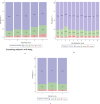Examining subjective well-being during pregnancy and its association with pregnancy intendedness among women in Nigeria: A population-based cross-sectional multilevel study
- PMID: 39464568
- PMCID: PMC11504940
- DOI: 10.1017/gmh.2024.99
Examining subjective well-being during pregnancy and its association with pregnancy intendedness among women in Nigeria: A population-based cross-sectional multilevel study
Abstract
In this study, we examined the patterns of subjective well-being (SWB) measures among pregnant women and quantified the extent to which pregnancy intendedness is associated with low SWB measures during pregnancy. We analyzed data from the 2021 Nigeria Multiple Indicator Cluster Survey comprising 3,491 pregnant women. The associations between pregnancy intention and low SWB measures (unhappiness, low life satisfaction [LS] and diminished optimism) were determined by fitting series of multilevel logistic regression models with random intercepts. Among pregnant women in our sample 20%, 37.5% and 9.6%, reported being unhappy, experiencing low LS and having diminished optimism, respectively. However, we found no significant association between pregnancy intention and being unhappy (mistimed: adjusted odds ratio [aOR] = 1.19, 95% CI = 0.88-1.60; unwanted: aOR = 1.16, 95% CI = 0.71-1.91), experiencing low LS (mistimed: aOR = 1.07, 95% CI = 0.83-1.37; unwanted: aOR = 1.06, 95% CI = 0.69-1.65) and having diminished optimism (mistimed: aOR = 1.22, 95% CI = 0.82-1.82; unwanted: aOR = 1.07, 95% CI = 0.56-2.04). Findings from the study suggest that pregnant women in Nigeria who reported having either a mistimed or unwanted pregnancy were just as likely to report being unhappy, experience low LS and have diminished optimism as women whose pregnancy was intended.
Keywords: happiness; life satisfaction; optimism; pregnancy intention; subjective well-being.
© The Author(s) 2024.
Conflict of interest statement
The authors declare none.
Figures


Similar articles
-
The association between pregnancy intendedness and experiencing symptoms of postpartum depression among new mothers in the United States, 2009 to 2011: A secondary analysis of PRAMS data.Medicine (Baltimore). 2017 Feb;96(6):e5851. doi: 10.1097/MD.0000000000005851. Medicine (Baltimore). 2017. PMID: 28178128 Free PMC article.
-
Pregnancy wantedness and adverse pregnancy outcomes: differences by race and Medicaid status.Fam Plann Perspect. 1997 Mar-Apr;29(2):76-81. Fam Plann Perspect. 1997. PMID: 9099571
-
Correlates of mistimed and unwanted pregnancy among women in the Democratic Republic of Congo.J Biosoc Sci. 2020 May;52(3):382-399. doi: 10.1017/S0021932019000518. Epub 2019 Aug 14. J Biosoc Sci. 2020. PMID: 31409440
-
Changes in intendedness during pregnancy in a high-risk multiparous population.Matern Child Health J. 2000 Sep;4(3):179-82. doi: 10.1023/a:1009523430135. Matern Child Health J. 2000. PMID: 11097505
-
Pregnancy Intention and Contraceptive Use among Women by Class of Obesity: Results from the 2006-2010 and 2011-2013 National Survey of Family Growth.Womens Health Issues. 2018 Jan-Feb;28(1):51-58. doi: 10.1016/j.whi.2017.09.010. Epub 2017 Nov 13. Womens Health Issues. 2018. PMID: 29146297
References
-
- Bearak J, Popinchalk A, Ganatra B, Moller A-B, Tunçalp Ö, Beavin C, Kwok L and Alkema L (2020) Unintended pregnancy and abortion by income region and the legal status of abortion: Estimates from a comprehensive model for 1990–2019. The Lancet Global Health 8(9), e1152–e1161. 10.1016/S2214-109X(20)30315-6. - DOI - PubMed
LinkOut - more resources
Full Text Sources
